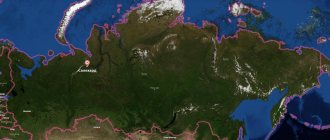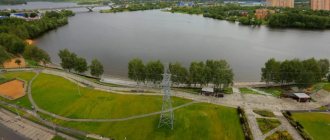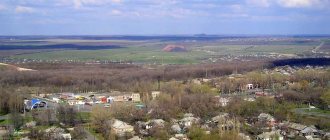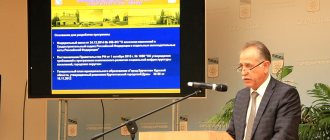The joint project “Small Cities from Great Heights” from Prospekt Mira is moving to the North. This time we decided to visit Lesosibirsk, a city whose life revolves around tall pines and majestic cedars. A city of contrasts, where the unprepossessing decoration of the province serves as a backdrop for the creative life of talented youth and intelligentsia.
Our guides to the woodworking capital of the Krasnoyarsk Territory were local student Daria Novikova and lawyer Olga Vtorykh, who spent her childhood there. And photographer Sergei Filinin showed us the city through the eyes of signalmen - from the heights of cellular masts. 4G mobile internet helped us navigate the city. Let us remind you that we have previously visited Achinsk, Nazarovo, Kansk and Zelenogorsk.
Lesosibirsk is a city stretching for many kilometers along the Yenisei. Long as a gut (this phrase is popular among locals), it takes locals an average hour to get from one end to the other. The only thing that saves us is public transport, which is simply excellent compared to Krasnoyarsk. Buses run on schedule until 1 am in all areas of the city, the buses are clean, and the conductors are polite.
Due to its structure, Lesosibirsk is strictly divided into districts. For example, the Belinsky district is quiet and intelligent, there are universities and a medical college there.
Nearby lies Victory Street - the main place for ostentatious promenades. Buying a new dress and not showing it off at Pobeda means buying it in vain. Whoever does not walk “on Victory” runs the risk of knowing eternal oblivion. In addition, Victory Street is a favorite place for dating.
Another place for walking is the embankment of the Maklakovka River, the historical center of the city. There, on Gorky, 34, there is a monument to the participants of the Yenisei-Maklakov uprising against Kolchak in 1919. And before there was a city beach here.
There are also areas that you definitely shouldn’t go to after dark. For example, Pirogov - dilapidated two-story houses, in which migrants or families with low social responsibility live because of their low cost. Or a new district - Yubileiny. This is social housing, into which people were moved compactly from wooden dormitories throughout the city.
Lesosibirsk on the map of Russia, geography, nature and climate
The city is located 295 km north of the capital of the Krasnoyarsk Territory, has approx. 60 thousand inhabitants. It stretches for 25-30 km along the left bank of the Yenisei and is a conglomerate of industrial zones surrounded by residential areas.
The urban district includes the working-class village of Strelka at the confluence of the Angara and the Yenisei (30 km to the south); in the north, the working-class village of Novoyeniseisk adjoins Lesosibirsk.
A satellite map of Lesosibirsk clearly shows that immediately beyond the city’s borders there begins an array of virtually untouched taiga with unique timber, the reserves of which have no analogues in the world. The sharply continental climate is characterized by long winters with frosts up to 50° and hot, dry summers with an average temperature of up to 18°.
Thanks to its favorable geographical and transport location, Lesosibirsk has every chance of becoming a springboard for the development of the Lower Angara region.
Forest Museum
9th microdistrict, 14
Here you will be told the whole history of the city, from the founding of a wooden fort to the timber industry center of the region. The museum reveals the history of the development of territories near the Yenisei. In addition to exhibits from the life and everyday life of the local population, samples of wooden architecture, and the fruits of the labor of local artisans, there are exhibitions entirely dedicated to the timber processing and wood chemical industries in the Krasnoyarsk Territory.
By the way, the museum has another branch - a separate exhibition hall, where exhibitions of local artists are held, with whom the local land is so rich. Therefore, there is a variety of different studios here that is unrealistic for a small town: clay plastics, beadwork, origami, and so on.
In addition, Lesosibirsk is a great place for raising and developing children. The Pedagogical University here trains highly qualified personnel; there are no problems with kindergartens in the city. In addition to classical schools, there is a gymnasium and a lyceum. The sphere of additional education is well developed: two music schools, two art schools, and quite successful dance groups. Children are engaged in robotics, orienteering, and tourism. And it costs pennies.
Routes on the map of Lesosibirsk. Transport infrastructure
The railway, road and water routes of the Krasnoyarsk Territory converge in Lesosibirsk.
- “ Yenisei Tract ” is a regional highway (04K-044) that connects Krasnoyarsk with Yeniseisk and passes through Lesosibirsk. The 340 km long highway runs through the taiga and has dangerous turns and rare gas stations. Buses run between Krasnoyarsk and Lesosibirsk (travel time - 5 hours). They make stops at 3 bus stations in the city: South (Lesosibirsk-post office); Central (5th microdistrict); Northern (in Novoyeniseisk)
- The railway from Lesosibirsk (at that time Maklakovo) to Achinsk was built in 1960 to transport timber throughout the country and for export; it connects the timber transshipment point on the Yenisei with the Trans-Siberian Railway. Once a day at night, a commuter train runs from Achinsk to Lesosibirsk (journey time - 6 hours), it arrives at the railway station located in the northern part of the city, from here you can go to the southern regions on routes No. 12 and No. 13 .
- The city's river port transports and ships timber, petroleum products, and building materials all year round. River routes go to the North and to the Angara region. Road transport leads to the Baikal highway; railway - to the Trans-Siberian Railway. The port has no passenger significance.
- Local bus routes start at the stop. "Military registration and enlistment office" in the southern part of the city and end in Novoyeniseisk at the stop. "Microdistrict A" Their route runs along the main Gorky Street with calls at the bus station in the city center (see map of Lesosibirsk with streets).
Lesosibirsk wood processing plant No. 1 (LDK)
st. Belinsky, 16e
LDK is the leading city-forming enterprise of Lesosibirsk, which to this day depends on the timber industry. This enterprise left an indelible mark on the hearts of children of the 90s. A frightening prospect was laid in the fragile minds: “If you don’t study, you’ll go to the LDK to stack boards!” Anyone who experienced a bright childhood in Lesosibirsk knows this phrase.
By the way, LDK was a source of bright events. The wood processing plant often brought rafts ashore to float the wood. And local children used them for fun. The fun could have disastrous consequences: someone almost had their leg torn off, someone fell from the raft straight into the cold river. But in the era of no Internet, rafts were the main children's entertainment in this city.
The Lesosibirsk forest is an integral part of the city landscape. Within the city there is a relict forest, which is a natural monument. Residents of Krasnoyarsk high-rise buildings can only dream of this. But in addition to the obvious advantages, this is a source of annoying inconvenience. And the main ones are mosquitoes and midges, and their names are legion. In the summer in Lesosibirsk, everyone wears the same perfume - mosquito spray.
Therefore, everyone who does not want to go to feed on mosquitoes can visit the forest museum.
Sights of the city of Lesosibirsk
Interesting sights can be found on the map of Lesosibirsk with houses.
- Holy Cross Cathedral - built in the 21st century, an example of the tent style, located in a cedar grove near the Yenisei.
- The Church of St. Andrew the First- Called is a cross-domed church in the Novgorod style.
- Palace of Culture on the street. Gorky - a presentable building from Stalin's times, here on the bank of the river. Maklakovka is a monument to the heroes of the Civil War.
- The wooden composition “Yenisei and Angara” - sculptures in the southern part of the city symbolize the confluence of two rivers.
- local history museum and the museum of Christian art are also of interest
Lesosibirsk City Drama Theater "Poisk"
Address: st. Pobeda, 6a
Perhaps the residents of Lesosibirsk will never tire of shouting about how wonderful the theater is here. They say that the local “Search” will give even the capital’s theaters a head start.
Competent management and talented actors, collaboration with playwrights and directors from different cities of Russia, the most talented chief director Oleg Hristolyubsky. There is a repertoire for children, classic classics in interesting readings, modern plays, and an interesting, fresh approach to productions. “Poisk” is a place that you should definitely visit if your visit to Lesosibirsk coincides with another performance.
By the way, Lesosibirsk is a unique place where the depressing appearance of a provincial town does not at all fit with the population inhabiting it. Do not forget that there are two universities in the city - the Lesosibirsk Pedagogical Institute and the Lesosibirsk branch of Siberian State University, which means there is a rather impressive layer of intelligentsia and students.
“Once upon a time, I myself was among those “normal youth” who left. I studied at the university in Krasnoyarsk, worked in Krasnoyarsk, and then at 23 I decided to return and now I’m studying at the university in Lesosibirsk,” says Daria Novikova. - I have something to compare with, there are wonderful young people here. I don’t know what’s the matter, but in Lesosibirsk there is a huge percentage of students who are holders of increased scientific scholarships, scholarships from the Government of the Russian Federation, the President of the Russian Federation, Oxford scholarships, sports scholarships and other evidence of their successful studies. Comparing with my first university in Krasnoyarsk, I never cease to be amazed at how motivated the guys here are - they try to get everything out of their studies and invest themselves to the fullest. So Lesosibirsk is no longer about squatting guys in tracksuits drinking beer in the evenings.”
Economy and industry of Lesosibirsk
The leading sectors of the city's economy are logging and wood processing. Main enterprises:
- Sawmill and woodworking plant No. 1 is a city-forming enterprise.
- Industrial group "Siberian Forest" is an enterprise for deep wood processing.
- Timber handling plant – produces sleepers and other sawmill products.
- Siberian Timber Chemical Plant - produces rosin and paint and varnish products.
- Novoyenisei Timber Chemical Complex - works for export, offers materials from Angara pine, larch, spruce.
The city's infrastructure is represented by the Trade Center, three hotels, and four restaurants.
Lesosibirsk
(Krasnoyarsk region)
OKATO code:
04422
Founded:
1975
City since:
1975 City of regional subordination
Urban-type settlements, population as of 01/1/2021
| Arrow | 4.6 |
| Telephone code (reference phone) | |
| 39145***** | 22-2-22 |
Deviation from Moscow time, hours:
4
Geographical latitude:
58°14′
Geographical longitude:
92°29′
Altitude above sea level, meters:
80 Sunrise and sunset times in the city of Lesosibirsk
Culture and art
The People's Association of Artists "Yenisei", which turns 60 years old in 2008, has more than 40 people. It includes not only professional artists (members of the Union of Artists of Russia), but also amateurs, masters of arts and crafts.
NGO "Creative Living Room" unites creative people of Lesosibirsk - poets, prose writers, musicians. Several collective collections and dozens of author's publications have been published. In addition, in Lesosibirsk, an artistic and journalistic almanac of creative associations of the Yenisei district of the Krasnoyarsk Territory “Perezvon” is published, headed by a member of the Union of Writers of Russia A. M. Bondarenko.
There are two theaters in Lesosibirsk - the City Drama Theater "Poisk" and the Youth Theater "Oko" based on the Central Children's Theater.
Cities
Lesosibirsk city
- a city in Russia, in the Krasnoyarsk Territory. A city of regional subordination on the territory of the Yenisei region, equated to the regions of the Far North. Located on the banks of the Yenisei River, 275 kilometers north of Krasnoyarsk and 30 km from the mouth of the Angara. The area of the city is 277 km?, the population is 64.2 thousand people (2011). Large center of sawmilling and wood chemicals. Located in the central part of Russia, in the southwest of the Trans-Angara plateau on the banks of the Yenisei River, 275 kilometers north of Krasnoyarsk and 30 km from the mouth of the Angara. The city has an advantageous transport and geographical location. The railway branch to Achinsk connects Lesosibirsk with the Trans-Siberian Railway, the Yenisei highway, going to Krasnoyarsk, gives access to the federal highway “Baikal” (M53), a powerful river port capable of processing about 1200 thousand tons of cargo per year. The Yenisei connects the city with the Northern Sea Route, and the Angara with the Lower Angara region. Thanks to these factors, Lesosibirsk is a convenient transport hub, which made it possible to include it in the North Siberian Railway project (SevSib) and position it as a springboard for the development of the Lower Angara region. The permanent chairman of the city committee of the CPSU of Lesosibirsk in 1975-1991 was Nikolai Terentyevich Kolpakov. From 1997 to 2010, he was the Head of the city and Chairman of the City Council. In March 2010, the former head of the Rosin Extraction Plant, Boris Aleksandrovich Zolin, was appointed the new head of Lesosibirsk. The head of the city administration in 2005-2010 was Valery Ivanovich Vopilov. In June 2010, Andrei Vladimirovich Khokhryakov was appointed as the new head of the administration.
Education in the city of
Lesosibirsk
Lesosibirsk Pedagogical Institute is a branch of the Siberian Federal University (LPI LfSFU) Lesosibirsk branch of the Siberian State Technological University (LfSibGTU). Lesosibirsk branch of the Modern Humanitarian Academy (SHA). Vocational school No. 14 Vocational school No. 48 Medical school
11 schools, including 1 lyceum, 1 gymnasium, 1 correctional school 16 kindergartens 8 institutions of additional education College “Knowledge” Orthodox gymnasium named after. St. John of Kronstadt Lesosibirsk Cadet Corps named after. A. B. Jordan
Economy of the city of
Lesosibirsk
The main industries are wood processing and processing, wood chemistry.
Large enterprises:
River port Lesosibirsk LDK No. 1 Lesosibirsk Timber Transshipment Plant (LPK) Lesosibirsk Rosin Extraction Plant (KEP) Maklakovsky LDK Novoyenisei LCC
History of the city of
Lesosibirsk
Since 1640, the village of Maklakov Lug existed on the site of modern Lesosibirsk. In the 19th century, Maklakovo became the center of the volost. At the beginning of the twentieth century, Norwegian industrialist Jonas Lied founded a timber processing plant, which created the economic basis for the future of the city. After the revolution, the Lida plant was nationalized and received the name Maklakovsky LDK-(2). After the Great Patriotic War, large sawmills were built in the Maklakovo area for processing Angara pine: Novoyenisei and Novomaklakovsky sawmills and wood processing plants, a timber transshipment base and a timber transshipment plant.
The Achinsk-Maklakovo railway line, 274 km long, was opened, which connected the village with the Siberian Railway.
The villages of Novomaklakovo and Novoyeniseisk were built for workers.
On January 15, 1975, on the basis of the Yeniseisk and Maklakovo piers, the Lesosibirsk port was created - now a subsidiary of the Yenisei River Shipping Company.
The city owes its appearance on the map of Russia to Nikolai Terentyevich Kolpakov. According to him, the name of the city fully reflects the specialization of the city and its geographical location:
I came up with the name of the city. There were two proposals that did not pass: to name the city Maklakovo, and this village has been known abroad since 1924. The government rejected this proposal. We believed that the name of the village of Maklakovo came from the traveler’s surname, but it turned out that he had never been to these parts. Scientists of the Academy of Sciences have deciphered the word “maklaki” - these are, they say, resellers of stolen goods. In Soviet times, of course, they could not allow the name of a city with this word. Then they began to consult. They tried to name the future city Novo-Yeniseisky, if only because the workers’ settlement had that name, and it was under administrative subordination. But it did not enter our city directly, according to the project it did not, and it was necessary to convene a meeting of residents and obtain their consent. The people did not agree. They began to think. An idea came to me: there is a city in Siberia called Novosibirsk, connected with Siberia, and we are foresters, we mainly have a timber industry... So - Lesosibirsk! It seems to fit all the parameters: forest, Siberia... They justified the name, and it was easily accepted by the government. "Krasnoyarsk newspaper", No. 84 December 12, 2006
According to another version, the name of the city was invented by a teacher at the Lesosibirsk Pedagogical Institute, Professor A.I. Malyutina, who won the competition for the best name of the future city.
By decision of the Presidium of the Supreme Council of the RSFSR No. 185 of February 21, 1975, the villages of Maklakovo and Novomaklakovo were transformed into the city of Lesosibirsk. In 1989, the village of Novoyeniseisk was annexed to Lesosibirsk.
| City coat of arms Lesosibirsk— In an ermine field there is a green wide pillar, burdened with a golden abstract spruce and supported on the sides by rising black sables with scarlet eyes and tongue. Author group: S. Belousov, I. Gorlov, V. Dyukov, K. Mochenov, Yu. Korzhik, K. Perekhodenko, G. Rusanova, G. Tunik. Approved by the decision of the Lesosibirsk City Council dated October 21, 2004 (#366). | The flag of the city of Lesosibirsk has not yet been approved, so it is not shown. |
Climate
| Climate of Lesosibirsk | |||||||||||||
| Index | Jan. | Feb. | March | Apr. | May | June | July | Aug. | Sep. | Oct. | Nov. | Dec. | Year |
| Absolute maximum, °C | 3,1 | 7,1 | 16,5 | 25,3 | 33,2 | 35,4 | 35,6 | 33,6 | 29,2 | 23,7 | 9,5 | 6,1 | 35,6 |
| Average maximum, °C | −10,1 | −9,8 | −1,2 | 6,7 | 12,8 | 19,3 | 21,9 | 17,9 | 10,8 | 4,2 | −4,1 | −10,5 | 4,8 |
| Average temperature, °C | −21,6 | −19 | −9 | 0,4 | 8,0 | 15,4 | 18,3 | 14,7 | 8,9 | −0,1 | −10,7 | −18,8 | −1,1 |
| Average minimum, °C | −32,5 | −32,6 | −18,3 | −5,6 | 3,6 | 10,2 | 16,1 | 11,8 | 3,8 | −5,6 | −23,5 | −34 | −8,8 |
| Absolute minimum, °C | −58,8 | −53,3 | −47,1 | −35,6 | −17,1 | −3,9 | 1,2 | −3,1 | −8,9 | −33,6 | −49 | −54,5 | −58,8 |
Population
Population 64.4 thousand people. (2007)
Number of residents of the city of Lesosibirsk by year (in thousands)
| 1939 | 1959 | 1970 | 1979 | 1989 | 1992 | 1996 | 1998 | 2000 | 2001 | 2003 | 2005 | 2006 | 2007 |
| 56,4 | 13,8 | 25,0 | 38,6 | 68,3 | 69,9 | 69,7 | 69,3 | 68,5 | 68,2 | 65,4 | 64,9 | 64,6 | 64,4 |
Authorities
The permanent chairman of the city committee of the CPSU of Lesosibirsk in 1975-1991 was Nikolai Terentyevich Kolpakov. From 1997 to 2010, he was the Head of the city and Chairman of the City Council. In March 2010, the former head of the Rosin Extraction Plant, deputy head of the Lesosibirsk city administration for long-term development, Boris Aleksandrovich Zolin, was elected the new head of Lesosibirsk from the deputies of the city council.
The head of the city administration in 2005-2010 was Valery Ivanovich Vopilov. On May 18, 2010, Andrei Vladimirovich Khokhryakov was appointed deputies of the City Council.








